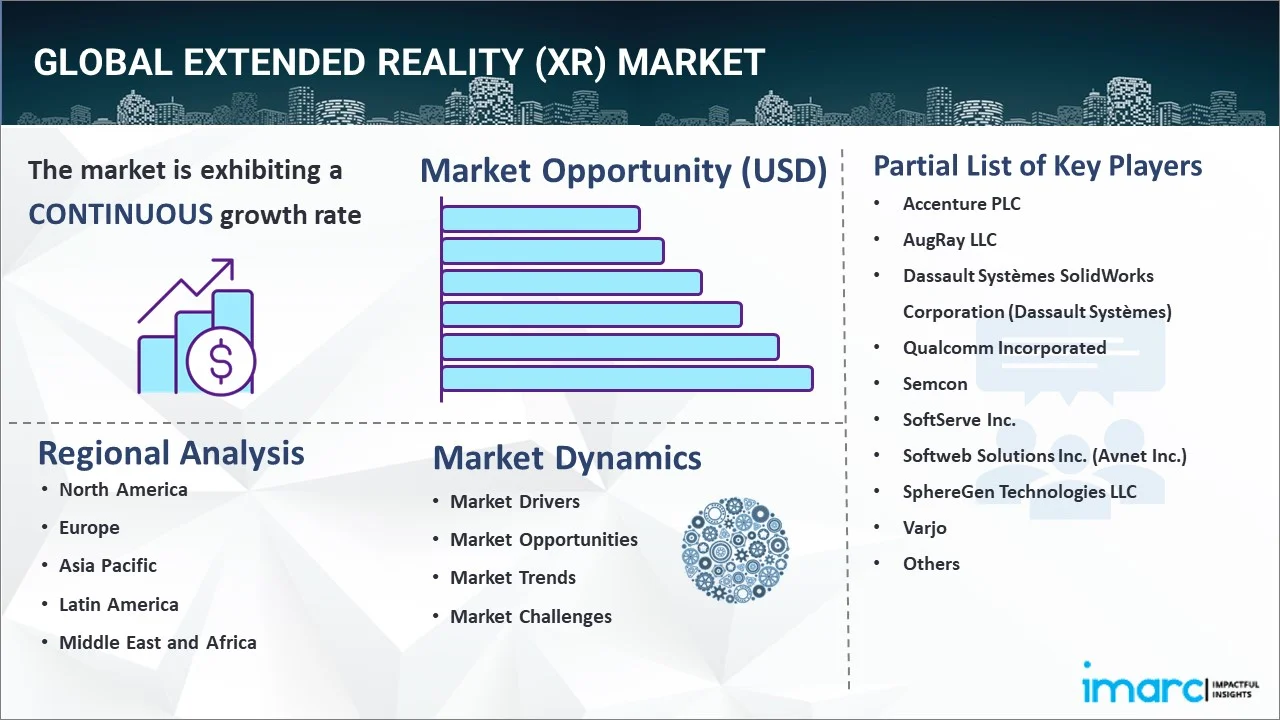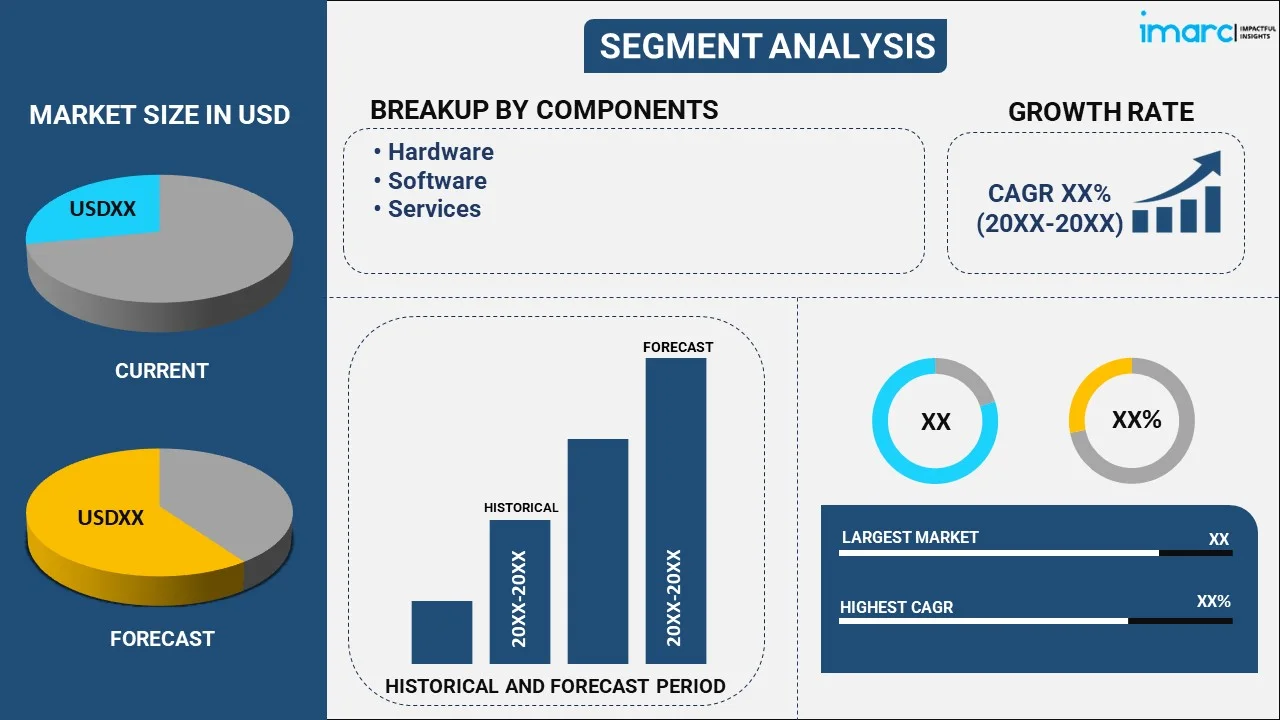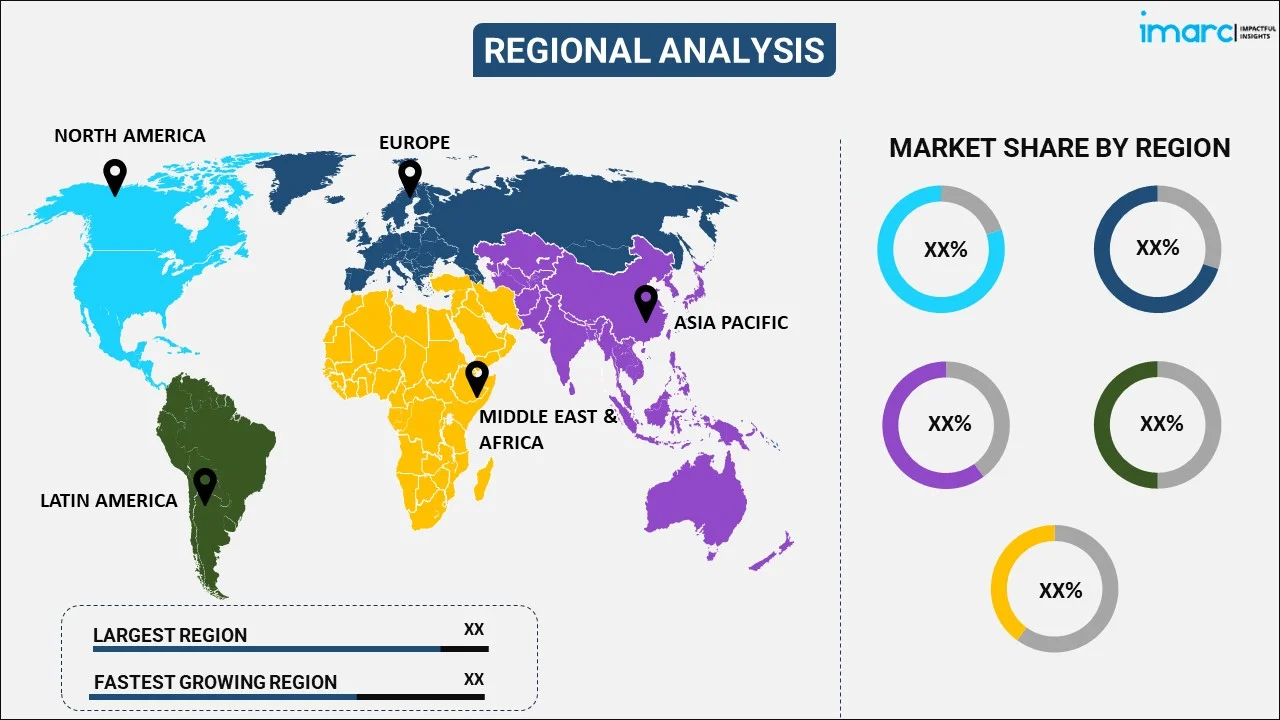
Extended Reality (XR) Market Report by Component (Hardware, Software, Services), Type (Consumer Engagement, Business Engagement), Organization Size (Small and Medium-sized Enterprises, Large Enterprises), Application (Virtual Reality (VR), Augmented Reality (AR), Mixed Reality (MR)), End User Industry (Education, Retail, Industrial and Manufacturing, Healthcare, Media and Entertainment, and Others), and Region 2025-2033
Extended Reality (XR) Market Size:
The global extended reality (XR) market size reached USD 128.8 Billion in 2024. Looking forward, IMARC Group expects the market to reach USD 2,530.2 Billion by 2033, exhibiting a growth rate (CAGR) of 37.26% during 2025-2033. The increasing consumer awareness and acceptance of XR technologies, the rising adoption of cultural heritage preservation and virtual museums, and the growing use of military and defense applications for training and simulations are some of the factors propelling the extended reality market growth.
|
Report Attribute
|
Key Statistics |
|---|---|
|
Base Year
|
2024
|
|
Forecast Years
|
2025-2033
|
|
Historical Years
|
2019-2024
|
| Market Size in 2024 | USD 128.8 Billion |
| Market Forecast in 2033 | USD 2,530.2 Billion |
| Market Growth Rate 2025-2033 | 37.26% |
Extended Reality (XR) Market Analysis:
- Major Market Drivers: The increasing adoption of immersive technologies in industries such as gaming, entertainment, healthcare, and education is a significant driver for the extended reality market share.
- Key Market Trends: The integration of augmented reality (AR), virtual reality (VR), and mixed reality (MR) technologies into enterprise workflows is a key trend shaping the extended reality market trends.
- Geographical Trends: North America is leading the market, driven by early adoption, technological advancements, and a strong ecosystem of XR companies and developers.
- Competitive Landscape: Accenture PLC, AugRay LLC, Semcon, and SoftServe Inc. are some of the key market players driving the extended reality market demand.
- Challenges and Opportunities: While technical challenges like hardware limitations and user experience remain, extended reality market opportunities abound in sectors such as industrial training, virtual events, and immersive storytelling, driving innovation and growth in the extended reality market recent developments.

Extended Reality (XR) Market Trends:
Rising availability and affordability of XR devices and equipment
The extended reality market statistics have been benefited by the rising availability and affordability of XR devices and equipment. In the past, there were expensive XR devices that were limited to certain sectors or enthusiasts. However, technology advancements, economies of scale, and increased competition have resulted in more accessible and cost-effective XR solutions. It is through the expansion of smartphones that people have managed to make use of this tech. Nowadays, most smartphones possess AR features making it possible for individuals to experience augmented reality without any other gadgets. This led to explosion in user base and greater AR applications market due to adoption of AR-ready mobile phones. With standalone VR headsets being less costly than before, they are also friendlier for users which makes virtual reality a more accessible experience for anyone wanting to try it out.
Rising use in the retail and e-commerce industry
The use of XR technologies in the retail and e-commerce industry has been rising, leading to a positive extended reality market outlook. The global extended reality market 2021 value reached USD 42.86 Billion, and as of the current year, is expected to grow at 39.2%, which indicates an impressive market expansion rate. XR is changing how shoppers browse and engage with products. AR also enables virtual product visualization where using their smartphones or AR glasses, customers are able to place digital furniture or décor items within real-life settings. This interactive experience helps consumers envision how products will fit into their homes thus bolstering confidence in purchase decisions made thereof. Furthermore, XR enhances the in-store experience through interactive displays and personalized recommendations. Retailers can utilize AR/VR technology to develop interactive product introductions, an immersive brand narrative, or virtual showrooms that will provide distinctive customer journeys.
Growing demand for marketing and advertising campaigns
There is a growing demand for XR in marketing and advertising campaigns. This is driving the extended reality market revenue. XR presents an opportunity to create more interactive marketing which is different from the old ways of doing things. One of the main applications of XR in marketing is augmented reality (AR). AR brands may create interactive commercials, whereby customers can scan print media or use mobile apps to receive extra digital content like 3D models, animations, or product information. Such kind of interaction enhances customer engagement and brand recall. Virtual reality (VR) is another strong tool that can be used in marketing campaigns. Brands can build VR experiences that take users into virtual environments matching their brand identity. These experiences could demonstrate products, simulate real-life scenarios, or produce branded entertainment content that strikes a chord with people. Mixed reality (MR) combines both virtual and physical landscapes into a single seamless experience where users interact together with them.
Extended Reality (XR) Industry Segmentation:
IMARC Group provides an analysis of the key trends in each segment of the market, along with forecasts at the global, regional, and country levels for 2025-2033. Our report has categorized the market based on component, type, organization size, application, and end user industry.
Breakup by Component:

- Hardware
- Software
- Services
The report has provided a detailed breakup and analysis of the market based on the component. This includes hardware, software, and services.
Breakup by Type:
- Consumer Engagement
- Business Engagement
Consumer engagement holds the largest share of the industry
A detailed breakup and analysis of the market based on the type have also been provided in the report. This includes consumer and business engagement. According to the report, consumer engagement accounted for the largest market share.
Customer engagement is increasing the extended reality market price. XR technologies engage customers with some unique and interactive touch. Customers want unique experiences even if it is virtual reality (VR) or mixed reality (MR). Marketing campaigns that are innovative, virtual try-on, and branded content are some of the efforts made for consumer engagement by businesses on XR. High consumer engagement will enhance brand visibility and customer loyalty, thus driving market demand.
Breakup by Organization Size:
- Small and Medium-sized Enterprises
- Large Enterprises
The report has provided a detailed breakup and analysis of the market based on the organization size. This includes small and medium-sized enterprises and large enterprises.
Breakup by Application:
- Virtual Reality (VR)
- Augmented Reality (AR)
- Mixed Reality (MR)
Virtual reality (VR) represents the leading market segment
The report has provided a detailed breakup and analysis of the market based on the application. This includes virtual reality (VR), augmented reality (AR), and mixed reality (MR). According to the report, the virtual reality (VR) represented the largest segment.
Virtual reality (VR) means creating computer-generated environments that can immerse users into entirely synthetic worlds. VR applications include gaming and entertainment up to training and simulations. This has resulted in the rise in demand for VR games as well as other forms of entertainment such as virtual travels, digital social interactions, and online training programs in a variety of fields among others. Businesses use XR for better product visualizations, remote collaboration, and interactive marketing purposes. Over time as technology matures cost reduction makes XR more affordable across various industries including education where it is used for experiential learning through institutions adopting it in other sectors like healthcare which employs it to conduct surgical simulations besides treating patients.
Breakup by End User Industry:
- Education
- Retail
- Industrial and Manufacturing
- Healthcare
- Media and Entertainment
- Others
Media and entertainment holds the largest share of the market
A detailed breakup and analysis of the market based on the end user industry have also been provided in the report. This includes education, retail, industrial and manufacturing, healthcare, media and entertainment, and others. According to the report, media and entertainment accounted for the largest market share.
The media and entertainment industry propels the growth of the market. XR technologies are revolutionizing content consumption. This is through VR headsets that provide immersive gaming experiences and interactive storytelling. In AR, real-time information overlays and interactive advertisements are used to enrich live events while MR creates captivating experiences by blurring the line between physical and digital worlds. Companies with a stake in XR content production promote innovation, as well as assist in broadening consumer uptake. As demand for immersive entertainment grows, the media and entertainment sector continues to push the boundaries of XR, thus enlarging this market and shaping future experiences.
Breakup by Region:

- North America
- United States
- Canada
- Asia-Pacific
- China
- Japan
- India
- South Korea
- Australia
- Indonesia
- Others
- Europe
- Germany
- France
- United Kingdom
- Italy
- Spain
- Russia
- Others
- Latin America
- Brazil
- Mexico
- Others
- Middle East and Africa
North America leads the market, accounting for the largest extended reality (XR) market share
The market research report has also provided a comprehensive analysis of all the major regional markets, which include North America (the United States and Canada); Asia Pacific (China, Japan, India, South Korea, Australia, Indonesia, and others); Europe (Germany, France, the United Kingdom, Italy, Spain, Russia, and others); Latin America (Brazil, Mexico, and others); and the Middle East and Africa. According to the report, North America accounted for the largest market share.
In the XR market, North America leads in innovation. The region has a vibrant XR development ecosystem due to the presence of tech giants, startups, and research organizations. It is home to some of the major companies who are leading in VR, AR, and MR technologies. For example, North America has a strong investment culture and supportive regulatory environment that promotes the growth of XR. Also, diverse industries in this region such as gaming and entertainment as well as healthcare and education are embracing XR for various applications. Due to a large number of consumers demanding immersion experiences, North America remains at the top most global markets.
Leading Key Players in the Extended Reality (XR) Industry:
The key market players are key drivers behind market growth through innovation, investment, and collaboration. They develop cutting-edge VR and AR. It is because they spend heavily on research, product development, and content creation aimed at expanding capabilities and accessibilities within XR solutions. This helps them to expand their ecosystems by working with hardware manufacturers, software developers, and content creators. New innovative start-ups contribute towards specialized solutions thus driving competition among niche players. Strategic partnerships with industries such as gaming or education contribute greatly in driving the adoption of XR leading to its expansion on the market.
The market research report has provided a comprehensive analysis of the competitive landscape. Detailed profiles of all major companies have also been provided. Some of the key players in the market include:
- Accenture PLC
- AugRay LLC
- Dassault Systèmes SolidWorks Corporation (Dassault Systèmes)
- Qualcomm Incorporated
- Semcon
- SoftServe Inc.
- Softweb Solutions Inc. (Avnet Inc.)
- SphereGen Technologies LLC
- Varjo
- VertexPlus Technologies Limited
(Please note that this is only a partial list of the key players, and the complete list is provided in the report.)
Latest News:
- April 2, 2024: Accenture PLC agreed to acquire Intellera Consulting, an Italian consultancy firm operating in the public administration and healthcare sectors. The company is planning to improve digital transformation capabilities for Italy’s public sector.
- March 18, 2024: Semcon announced that it has signed a new framework agreement with Sinfra, which is a national procurement centre with many member companies in district heating, electricity operations, sewage, and water.
- March 7, 2024: SoftServe Inc., an IT consulting and digital services provider, announced that it has become an inaugural partner to obtain the Amazon Web Services (AWS) Generative AI Competency.
Extended Reality (XR) Market Report Scope:
| Report Features | Details |
|---|---|
| Base Year of the Analysis | 2024 |
| Historical Period | 2019-2024 |
| Forecast Period | 2025-2033 |
| Units | Billion USD |
| Scope of the Report | Exploration of Historical Trends and Market Outlook, Industry Catalysts and Challenges, Segment-Wise Historical and Future Market Assessment:
|
| Components Covered | Hardware, Software, Services |
| Types Covered | Consumer Engagement, Business Engagement |
| Organization Sizes Covered | Small and Medium-sized Enterprises, Large Enterprises |
| Applications Covered | Virtual Reality (VR), Augmented Reality (AR), Mixed Reality (MR) |
| End User Industries Covered | Education, Retail, Industrial and Manufacturing, Healthcare, Media and Entertainment, Others |
| Regions Covered | Asia Pacific, Europe, North America, Latin America, Middle East and Africa |
| Countries Covered | United States, Canada, Germany, France, United Kingdom, Italy, Spain, Russia, China, Japan, India, South Korea, Australia, Indonesia, Brazil, Mexico |
| Companies Covered | Accenture PLC, AugRay LLC, Dassault Systèmes SolidWorks Corporation (Dassault Systèmes), Qualcomm Incorporated, Semcon, SoftServe Inc., Softweb Solutions Inc. (Avnet Inc.), SphereGen Technologies LLC, Varjo, VertexPlus Technologies Limited, etc. |
| Customization Scope | 10% Free Customization |
| Post-Sale Analyst Support | 10-12 Weeks |
| Delivery Format | PDF and Excel through Email (We can also provide the editable version of the report in PPT/Word format on special request) |
Key Benefits for Stakeholders:
- IMARC’s industry report offers a comprehensive quantitative analysis of various market segments, historical and current market trends, market forecasts, and dynamics of the extended reality (XR) market from 2019-2033.
- The research report provides the latest information on the market drivers, challenges, and opportunities in the global extended reality (XR) market.
- The study maps the leading, as well as the fastest-growing, regional markets. It further enables stakeholders to identify the key country-level markets within each region.
- Porter's five forces analysis assists stakeholders in assessing the impact of new entrants, competitive rivalry, supplier power, buyer power, and the threat of substitution. It helps stakeholders to analyze the level of competition within the extended reality (XR) industry and its attractiveness.
- The competitive landscape allows stakeholders to understand their competitive environment and provides insight into the current positions of key players in the market.
Key Questions Answered in This Report
The global extended reality (XR) market was valued at USD 128.8 Billion in 2024.
We expect the global extended reality (XR) market to exhibit a CAGR of 37.26% during 2025-2033.
The sudden outbreak of the COVID-19 pandemic has led to the growing demand for Extended Reality (XR) across several organizations for visualizing the live environment of the office and attending virtual meetings, on account of the rising deployment of a remote working model.
The rising adoption of online gaming as a profession, along with the increasing utilization of XR for immersive experiences, such as concerts and sports competitions on smartphones, is primarily driving the global extended reality (XR) market.
Based on the type, the global extended reality (XR) market can be divided into consumer engagement and business engagement. Currently, consumer engagement exhibits a clear dominance in the market.
Based on the application, the global extended reality (XR) market has been segregated into Virtual Reality (VR), Augmented Reality (AR), and Mixed Reality (MR). Among these, Virtual Reality (VR) currently holds the largest market share.
Based on the end-user industry, the global extended reality (XR) market can be bifurcated into education, retail, industrial and manufacturing, healthcare, media and entertainment, and others. Currently, the media and entertainment industry accounts for the majority of the global market share.
On a regional level, the market has been classified into North America, Asia-Pacific, Europe, Latin America, and Middle East and Africa, where North America currently dominates the global market.
Some of the major players in the global extended reality (XR) market include Accenture PLC, AugRay LLC, Dassault Systèmes SolidWorks Corporation (Dassault Systèmes), Qualcomm Incorporated, Semcon, SoftServe Inc., Softweb Solutions Inc. (Avnet Inc.), SphereGen Technologies LLC, Varjo, and VertexPlus Technologies Limited.
As technology continues to advance, XR is poised to revolutionize various industries, including gaming, entertainment, education, healthcare, and manufacturing. With the development of more affordable and immersive devices, XR is expected to become more accessible to the general public, leading to widespread adoption and significant market growth.
Need more help?
- Speak to our experienced analysts for insights on the current market scenarios.
- Include additional segments and countries to customize the report as per your requirement.
- Gain an unparalleled competitive advantage in your domain by understanding how to utilize the report and positively impacting your operations and revenue.
- For further assistance, please connect with our analysts.
 Inquire Before Buying
Inquire Before Buying
 Speak to an Analyst
Speak to an Analyst
 Request Brochure
Request Brochure
 Request Customization
Request Customization




.webp)




.webp)












